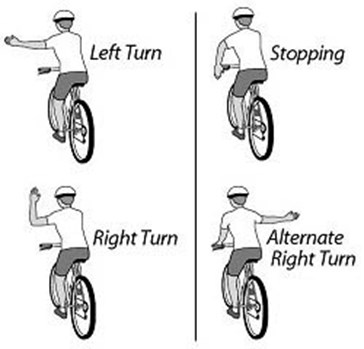Signaling
Figure 1. Watch this short League of American Bicyclists video to learn more about how to signal on a bicycle.
When riding a bike on the road or trail, one of the most important things you can do to avoid a crash is to be predictable. Motorists share their intentions with turn signals and brake lights. You can communicate the same information with hand signals (Figs. 1 & 2).

Figure 2. Signals for turning and stopping on a bicycle.
If you’re not used to using hand signals on your bicycle, it may feel kind of hokey at first. However, communication and predictability are key to safe and pleasant coexistence with drivers and with other riders.
Veteran Tip: The “typical” right turn signal in the bottom left corner of Fig. 2 is a hold-over from when automobiles didn’t have turn signals. Drivers had to use their left arm for all signals because their right arms were not visible inside the vehicle. Cars have had turn signals for a long time and some drivers may not understand this “typical” right turn signal. Consider using the “Alternate Right Turn” signal instead; pointing to the direction you intend to travel is more intuitive and better understood by road users around you.




 Trash & Recycling
Trash & Recycling
 Online Payments
Online Payments
 City Documents
City Documents
 Parks
Parks
 Traffic Court
Traffic Court
 E-NEWS
E-NEWS
 EXPLORE
EXPLORE
 NEWS
NEWS
 TRANSLATE
TRANSLATE
